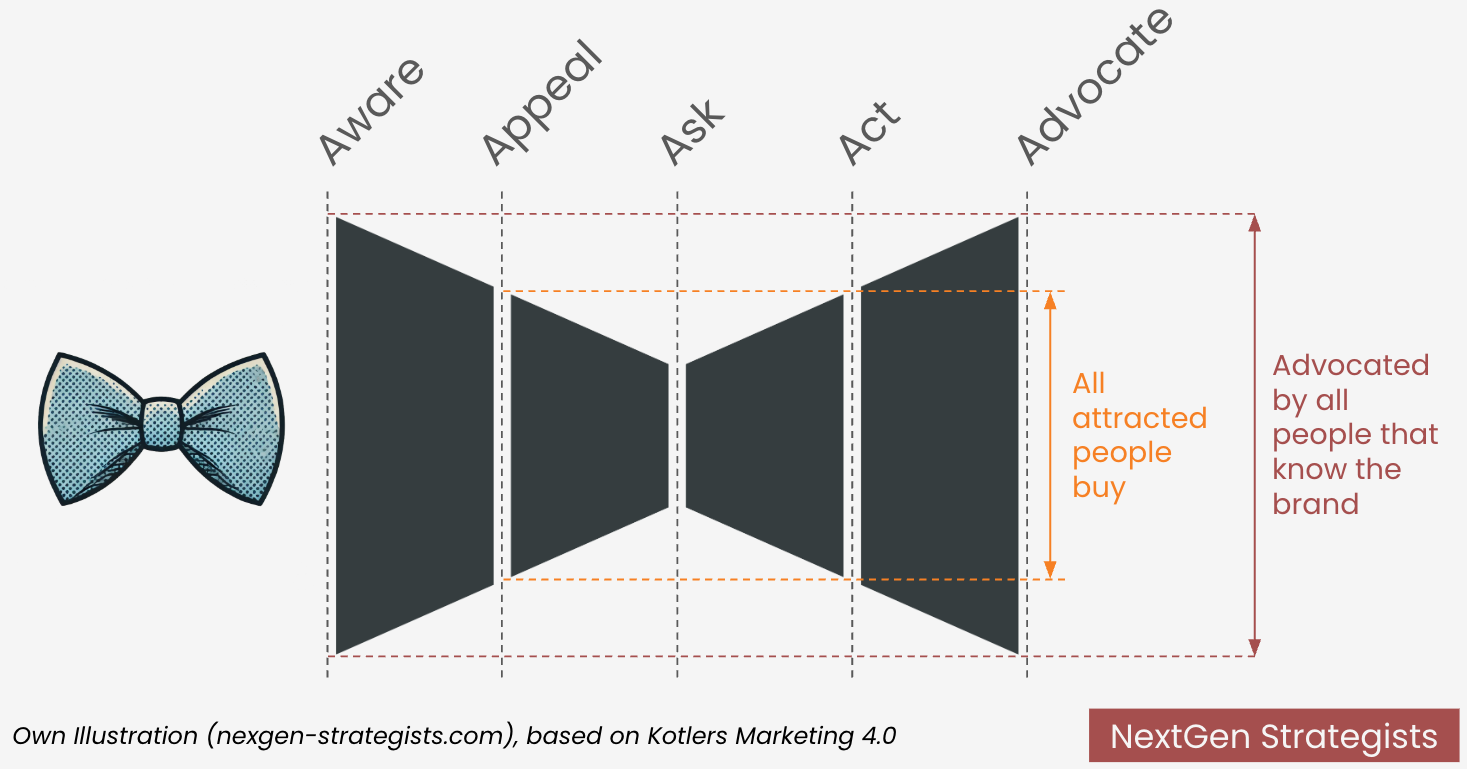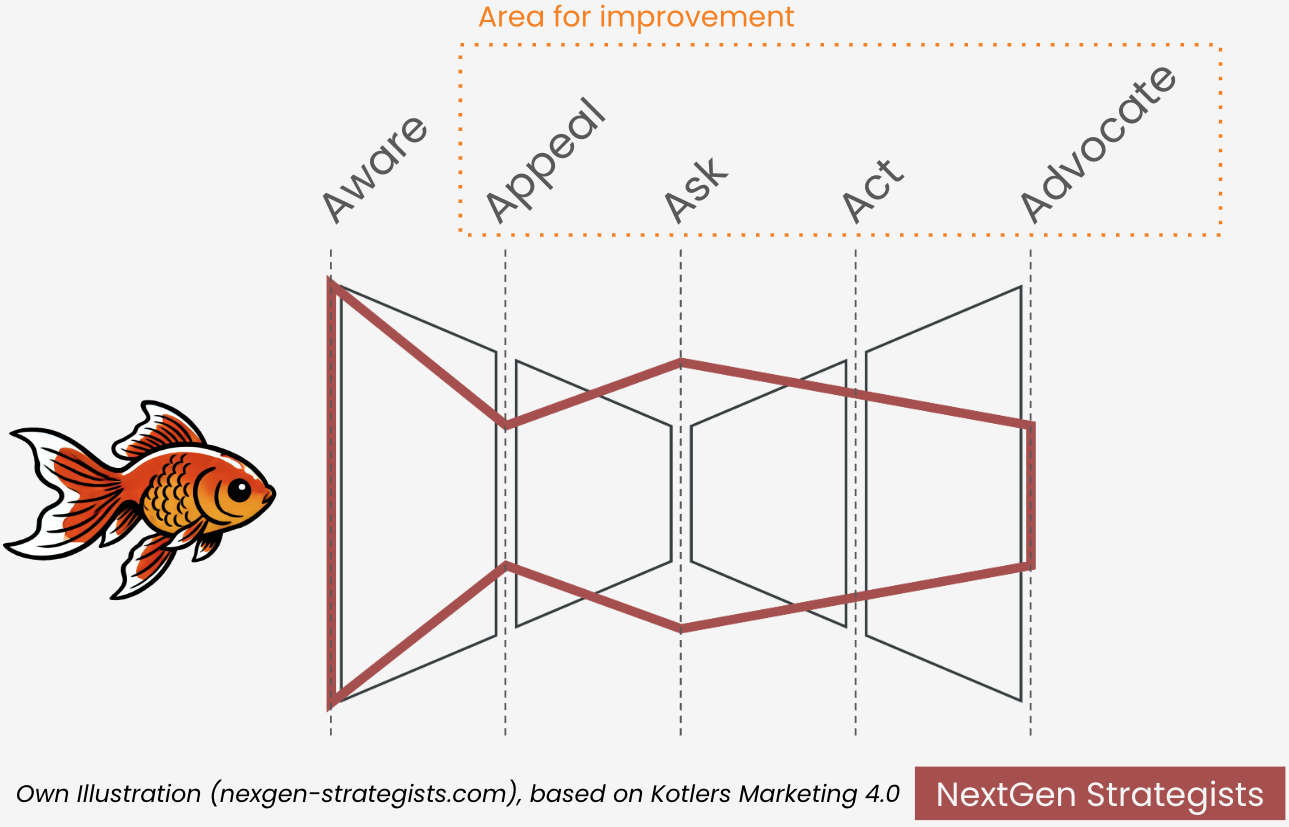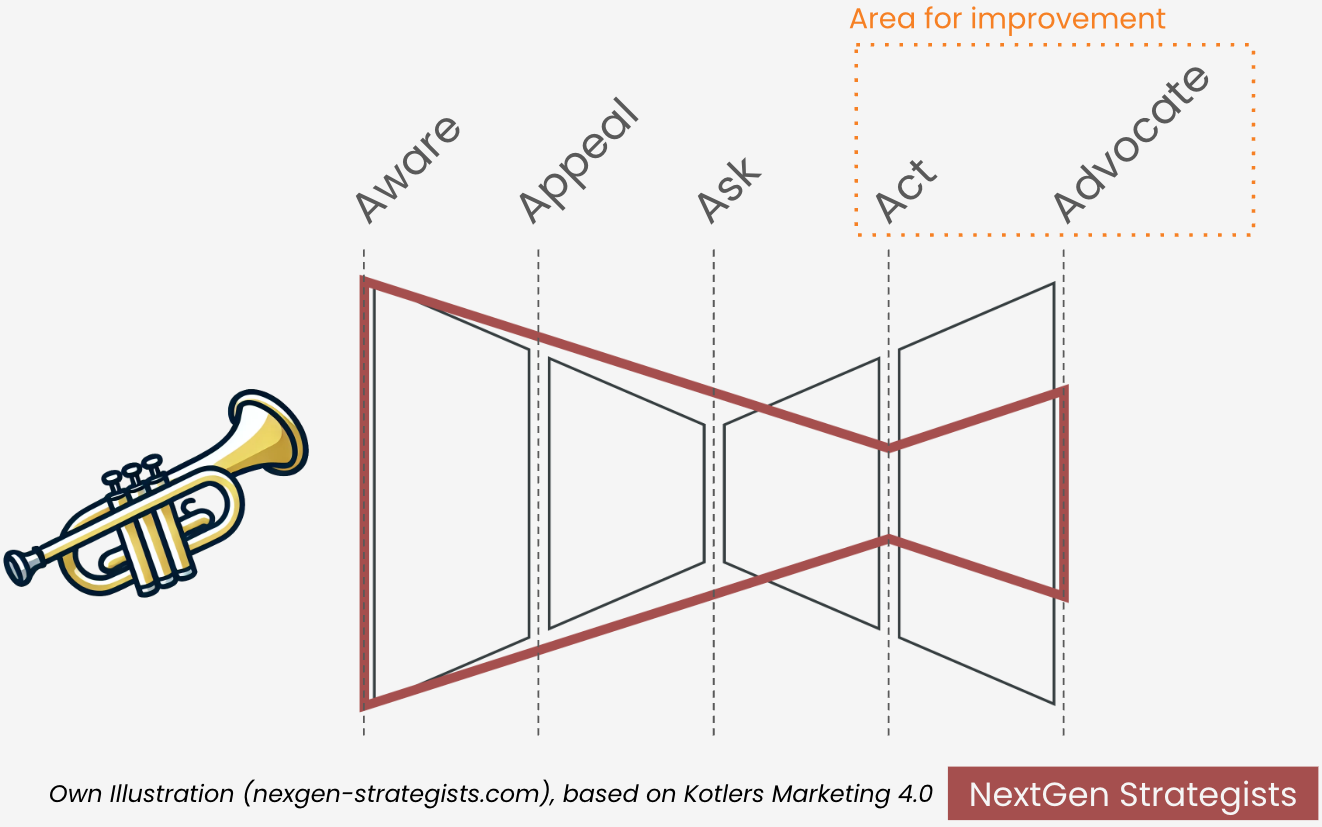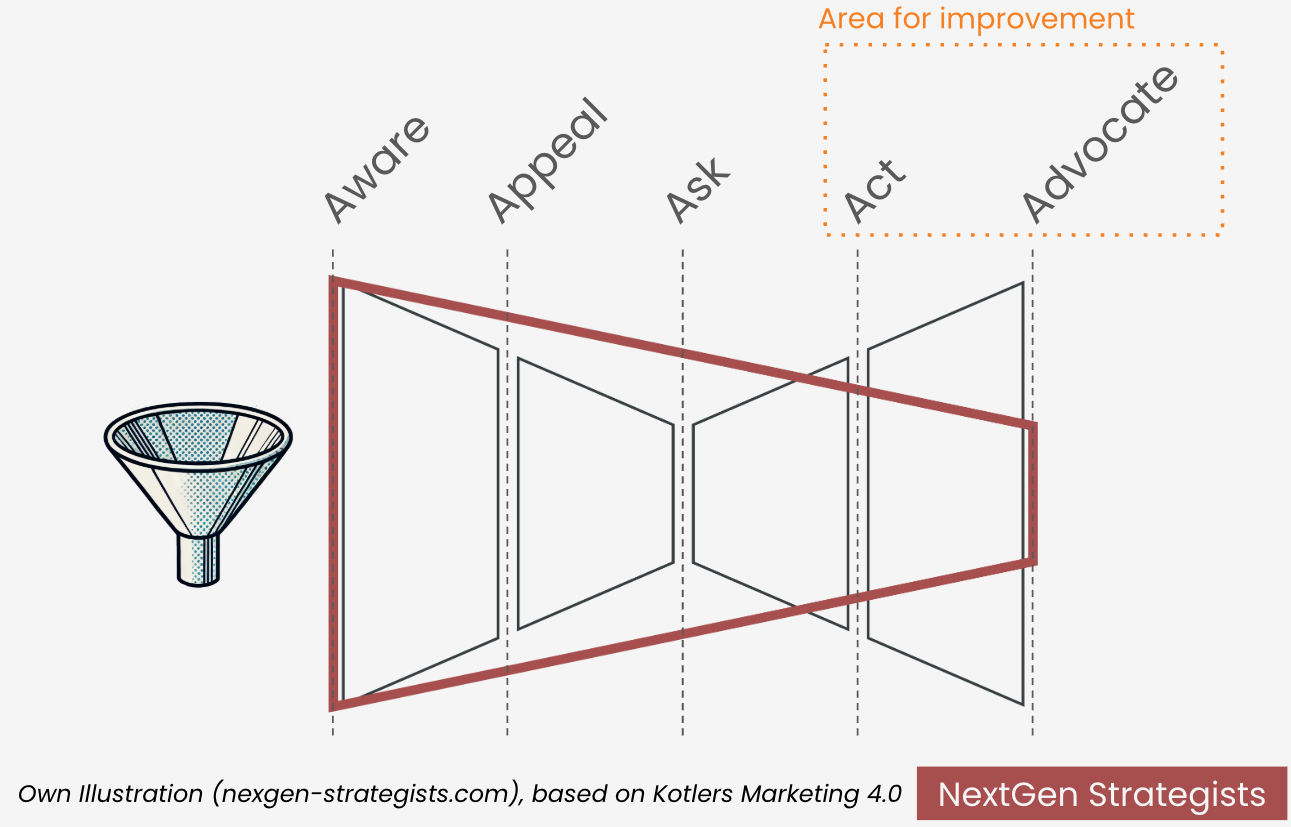Mastering the 5A’s journey in B2B sales
-
There are five distinct customer journey patterns:
• Door Knob – Customers make quick, routine purchases with little research. Optimize by ensuring product availability, maintaining strong distribution channels, and following up post-purchase to build loyalty.
• Goldfish – Customers conduct detailed research before buying. Optimize by offering rich, transparent content (case studies, whitepapers, webinars) and providing consultative sales support throughout their long evaluation process.
• Trumpet – Customers show high brand affinity and advocate for the brand even before purchasing. Optimize by converting advocacy into sales through flexible pricing or scaled options and by engaging passionate fans with community initiatives.
• Funnel – Customers progress linearly with drop-offs at each stage. Optimize by creating a consistent, seamless experience with personalized follow-ups at each step, ensuring clear value propositions from awareness through to purchase.
• Bow Tie – Nearly everyone aware of the brand becomes both a buyer and an advocate. Optimize by removing friction across all touchpoints, exceeding customer expectations, and delivering outstanding post-purchase support to maintain high conversion and advocacy rates.
The different shapes of a 5A’s customer journey
What does a Goldfish, a Door Knob, a Trumpet, a Funnel, and a Bow Tie have in common? What starts like a bad joke, actually answer your questions on how to optimize a customer journey. If you followed my last article about customer journey and personas, you may are at the point, where you want to improve. You may ask yourself: What stages are most relevant for my business? What stages should I focus on? How should the customer journey look like to optimize revenue?
These questions can be answered with the strange sounding patterns or “shapes” mentioned above. Let me explain:
Each business might see its customers progressing through the 5A’s in a distinct pattern. There are five common patterns. These are referred to as the Door Knob, Goldfish, Trumpet, Funnel, and Bow Tie. In this article, I will elaborate the concept behind each of these, and what are the implications on the sales process.
If you are not familiar with the concept of customer journeys, check out my last article.
Evaluate your own 5A’s pattern
To be able to improve your customer journey, it’s important to know the shape. Drafting this shape is no exact science. It’s a tool to guide your efforts in the right direction. Follow these steps to find out your company’s customer journey pattern:
Map your customer touchpoints:
Take your list with all your touchpoints throughout the customer journey (see https://www.nextgen-strategists.com/blog/how-to-build-a-customer-journey-in-b2b for more insights on this topic).Gather and analyse data:
Look at metrics like website visits, conversion rates, time spent, and drop-off points. Additionally, use surveys, interviews, and support feedback. Analyse all these data points to understand how many customers are present or active in each of the 5A’s stages.Draw your shape:
Based on the results of 2. draw your customer journey shape.
Now, you can compare your shape with the following types of journeys to understand the implications and how to improve.
Bow Tie: Ideal journey, high conversion to advocacy
The Bow Tie pattern represents the ideal customer journey shape in Kotlers 5A framework. The Bow Tie pattern means almost everyone who is aware of the brand becomes an advocate, a perfect conversion of awareness into loyalty. It also implies that those who develop interest and ask questions almost always end up purchasing (high conversion from Appeal/Ask to Act).
This scenario describes a brand that not only wins customers, but wins their hearts. Few companies achieve a true bow tie pattern, but it’s a benchmark to strive for.
Bow Tie Pattern illustrated
Example
A specialized enterprise SaaS platform provides outstanding value in a particular industry (e.g., an analytics tool for healthcare). They don’t market broadly, but through word-of-mouth, many potential customers become aware of them. Those who show appeal and move to ask for a trial almost invariably end up adopting the software because it meets their needs so well. After implementation, these clients are so satisfied with the results and the vendor’s support that they advocate vigorously. The vendor’s new leads often come directly from such referrals.
Goldfish: High curiosity, deliberate decision
The Goldfish pattern is almost the opposite of the Door Knob: High curiosity before commitment. In this journey type, customers spend a lot of time in the Ask stage. They seek information, ask questions, compare options, before deciding to Act. Most B2B transactions fall into the Goldfish pattern, since business buyers tend to research and consider multiple options for major purchases. The appeal towards a brand might not be strong at first. The buyer’s curiosity drives them to explore and ask questions to many different suppliers. Only after this inquiry and comparison phase will they purchase (Act). The purchase is made as a rational choice, not necessarily an emotional connection. This means that advocacy isn’t guaranteed.
Goldfish pattern illustrated
Example
Consider a mid-sized company looking for a new cloud infrastructure provider. The IT manager and their team might research multiple vendors, read case studies, ask for peer recommendations, and trial some services. They are very curious, spending several months in the evaluation phase. But they may not feel a strong emotional pull to any brand early on. Eventually, they choose the provider that best meets their technical needs and budget requirements. They could become advocates if the solution impresses them over time, but initially the decision is calculated.
Marketing & sales implication
If your product or service fits in the Goldfish pattern, you must support a long, information-rich buying process. Provide the right information and assistance at every step. Marketing should focus on content and education (think whitepapers, detailed product specs, webinars, case studies, and comparison guides). Ensure that when potential customers seek answers (high “Ask”), your brand provides helpful and transparent information. This satisfies their curiosity and builds trust.
From the sales perspective, patience and consultation are key. Salespeople should act as advisors or consultants, guiding buyers through their extensive evaluation rather of pushing for a quick close. Offerings like workshops, Q&A sessions with product experts, or pilot programs help to address the high need for information.
The more customer-centric you are during the research phase, the more likely you will earn the sale. Optimize for curiosity and build commitment and affinity over time. If done well, all that careful nurturing can pay off in stronger advocacy after purchase, as the customer feels their needs were understood and met.
Door Knob: Low curiosity, quick commitment
The Door Knob pattern is characterized by quick commitment despite low curiosity. Customers in this journey shape don’t spend much time researching or comparing brands and products. They move from awareness to purchase quickly, often out of habit or convenience. This is common for low-cost, frequently purchased goods. In a B2B context, you may see a door-knob-like pattern with routine or commodity purchases.
The appeal and even asking stage are minimal. Buyers feel little need to ask many questions or compare options for such straightforward transactions. They act (purchase) out of convenience or prior familiarity. Their emotional attachment to the brand is low. As a result, very few of these customers become advocates for the brand.
Door knob pattern illustrated
Example
A small manufacturer buys the same standard parts from a vendor repeatedly because the price is low and delivery is fast. They don’t research other brands (low curiosity) and purchase habitually (quick act). However, they aren’t particularly loyal or enthusiastic – if a part is out of stock, they’ll simply grab another brand without much concern.
Marketing & sales implications
In this pattern, the purchases are almost automatic, but the customer relationship is shallow. Marketing’s job here is to stay visible and available. Ensure your product or service is easy to find and easy to purchase. For instance, maintain strong distribution channels and presence. You have to “be there” at the moment of the purchase decision. Since buyers aren’t actively researching, brand availability and convenience are more important than differentiation. You might focus on being the fastest and most reliable supplier rather than overloading customers with information.
To improve advocacy, consider ways to engage customers post-purchase. This may develop more affinity for your brand. For example, follow up with excellent customer service, solicit feedback, or introduce loyalty programs. This post-purchase engagement can gradually turn a habitual buyer into a more loyal, advocating customer.
In short, even if customers aren’t initially curious about you, be curious about them: Reach out, understand their ongoing needs, build a relationship beyond the transactional. This turns a commodity-style interaction into a more customer-centric one.
Trumpet: High affinity, advocacy exceeds purchases
The Trumpet pattern distinguishes itself through how much the brand is loved by the customers (high affinity). In a trumpet-shaped journey, many people advocate for the brand even if they haven’t bought (acted) yet. This shape is commonly seen in lifestyle and luxury markets. While less common in B2B, it can happen in industries where a brand’s reputation and aspirational value are strong. A certain cutting-edge enterprise software or top consulting firm has a “buzz” around it. Many businesses talk about it as the gold standard. Smaller companies or prospects with limited budgets might admire and recommend that solution based on its reputed quality. Even if they haven’t become customers. Essentially, the brand has high appeal and even higher advocacy, but actual purchase numbers are lower, often due to barriers like cost or accessibility). We see advocacy > action. A lot of word-to-moth and positive sentiment, but a smaller pool of actual buyers.
Trumpet pattern illustrated
Example
A renowned enterprise software platform known for innovation in AI. Many tech leaders in various companies follow this platform’s thought leadership content, share its case studies, and speak highly of its capabilities. However, only a fraction of those actually purchase and implement the platform. Perhaps because it’s expensive or complex. Those who don’t buy might still cite this platform as an inspiration or recommend it to others.
Marketing & sales implications
A trumpet pattern suggests your brand has a strong appeal and brand affinity. Which is a great asset. People love and trust your brand story, even beyond your customer base. From a sales perspective, you’re not converting all that positive sentiment into purchases. To capitalize more on this behaviour, first understand why fans aren’t becoming buyers. Often in B2B, the reasons are practical: price, limited availability, or specific feature gaps. Marketing can help by widening accessibility. For example, offering scaled version of your products or services, or flexible pricing for smaller clients. Make your products more accessible to those who love your brand. For luxury brands, this may be another story, but in B2B this strategy could increase your sales results.
Additionally, you should further nurture your advocates. Those fans can influence others in the buying committee or in the industry. Provide them with shareable content, invite them to webinars or community forums, and keep them engaged. Essentially, treat passionate non-customers almost like customers because advocacy is valuable.
Funnel: Classic journey, steady progress
The Funnel pattern appears as the most straightforward: customers move through each of the 5A stages in sequence with significant consideration. The number of leads narrows at each step. Awareness leads to interest, which leads to inquiry, then to purchase, and finally, some become advocates. You’ve got a predictable drop-off at each stage. Many well-planned B2B purchase processes resemble this pattern. Consumer durables and service industries often follow the funnel pattern. In B2B, these could be capital goods or any scenario with a high-involvement, methodical decision process. Each stage is important to the outcome. However, in the digital age, a pure funnel shape is less common. Many B2B organizations still plan their sales cycle with a funnel mindset: guiding prospects step by step.
Funnel pattern illustrated
Example
A mid-sized enterprise is selecting a new CRM system. They begin by becoming aware of 10 possible vendors through industry reports and conferences. Of those, perhaps 5 have enough appeal (features and reputation) that they are considered. The team asks for demos and detailed proposals from these 5, and after evaluations, they act by purchasing one solution. Over the next year, as the CRM is implemented and used, the company’s stakeholders might turn into advocates if it delivers great results.
Marketing & sales implications
Because customers touch every stage, you must manage the entire customer experience. This requires a high effort across marketing, sales, and even post-sales. Every stage is an opportunity to either move the customer forward or lose them. Marketing should fill the funnel with the many of the right prospects. For this, focus on brand awareness and a compelling value proposition. Then, as interested prospects evaluate options, consistency is key. The information they find, the messages they receive, and the experience thy have across channels should all align and reinforce their interest.
For sales, the funnel pattern means working closely with marketing to nurture leads through the pipeline: timely follow-ups, personalized demos, addressing specific concerns, etc.
Optimizing a ‘standard’ sales process needs a lot of commitment and effort to do so. You have to exceed customer expectations at every stage. Your main focus should be on deepening customer commitment and affinity. For instance, don’t just stop a making the sale. Ensure your product delivers value and your customer service impresses them. By removing friction at each stage, you can increase the conversion rate and gain more advocates, which is essentially moving your funnel shape closer to the ideal bow tie (coming up next).
Conclusion: Customer Journey Patterns are tools to improve
Every business wants loyal customers who buy repeatedly and recommend the brand to others. You should edge towards the ideal Bow Tie. This is achieved by understanding why customers behave that way and adjusting your marketing and sales strategy accordingly. The better you know how your customers’ journey actually looks like, that better you can influence sales decisions.
Remember
These patterns are not fixed destinies. They are tools. Use them to spark discussions in your team: Which pattern do we see with our customers? Where are we losing people, and how can we better serve them there? These reflections can drive your business to the next level.








